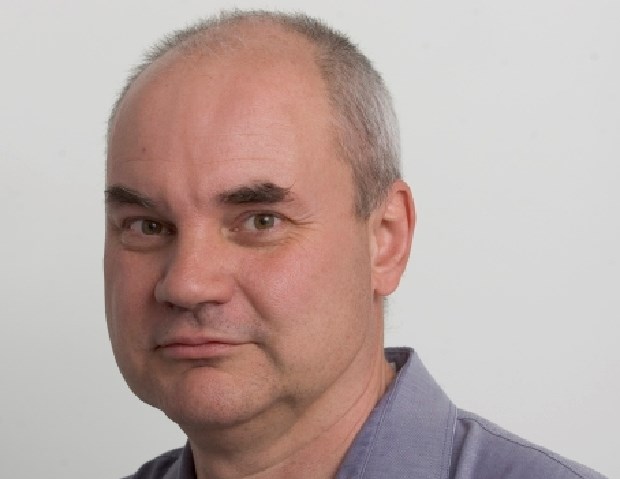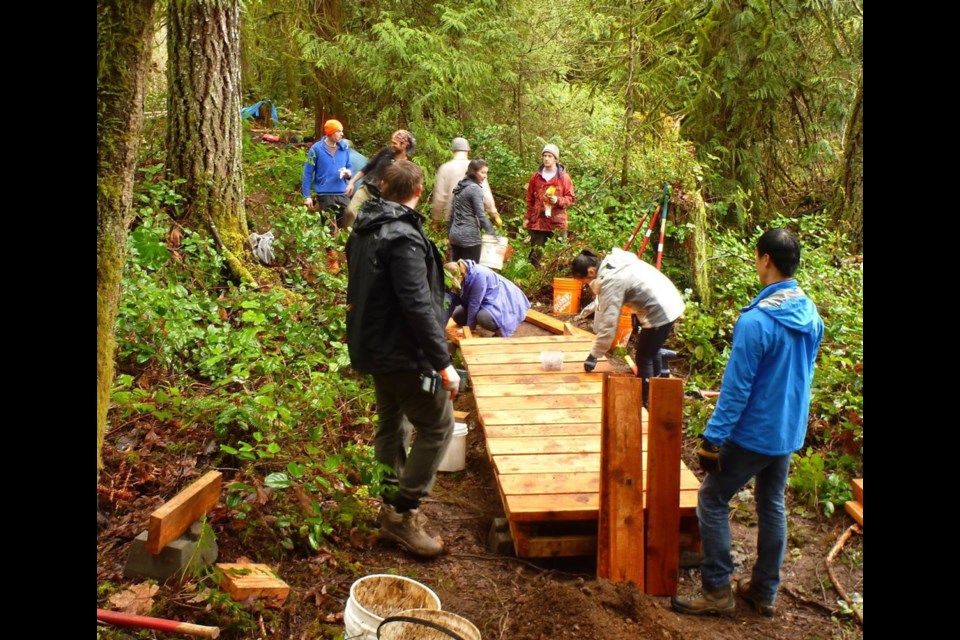 Electric Avenue is an unlikely name for what looks like a deer trail through the Highlands.
Electric Avenue is an unlikely name for what looks like a deer trail through the Highlands.
“It shows you don’t have to take a bulldozer and truck in to build a trail for all users,” enthuses Lister Farrar as he tromps through the trees.
He should know. The kids he coaches in the Tripleshot youth cycling team helped build it. So did other volunteers, including the crews of a couple of Navy submarines.
It was all bull labour, no machinery or power tools involved in building a narrow path that twists a kilometre or so through the bush.
It’s part of a big vision, though. The Southern Vancouver Island Nature Trails Society wants to piece together a whole network that it thinks could prove as big a draw as the West Coast Trail, Grouse Grind or Kettle Valley Rail Trail.
The idea is to work with landowners and local governments to build on existing trails — some official, some not — and link together recreational corridors for hikers, off-road runners, dog walkers, cyclists and horse riders.
It would also be an alternative to the status quo — the wide, manicured trails found in some local parks, or the under-the-radar paths carved out of the woods by mountain bikers.
It’s this last image — that of the outlaw Red Bull Rampage wild man ripping through the woods — that makes some people curl their lips when you mention mountain biking, and that gives the trails society a hurdle to clear.
The flip side is that if trails are going to be built anyway, might as well build them right, in a sustainable fashion, with the blessing of officialdom. Farrar is a big fan of the natural-look, multi-use single tracks fashioned by the trails society and its executive director, Daniel Cammiade.
“They’re more sustainable than other trails, built with better rock-base layers so they can take weight of horses and resist erosion,” Farrar says.
Pausing in the forest, he points to the features of the kilometre-long Electric Avenue, found at the end of Lost Lake Road: Trails are topped with mineral soil that won’t turn to slop when it rains. Rocks are placed around exposed tree roots to protect them from bike tires and horse hooves. Switchbacks not only act to reduce riders’ speed and open up sightlines, but ensure that water runoff flows across trails, not down them, so trails don’t become muddy ditches. Boardwalks protect bogs. Vegetation is restored right up to the tread.
“It looks like deer might have made it, but it can take all non-motorized users,” Farrar says. The horse droppings at his feet emphasize that point.
In the two years of its existence, the society has built about six kilometres of trail, including the Canada Cup and other routes on Bear Mountain and a two-kilometre path on Langford’s Skirt Mountain.
It’s done through a combination of paid and volunteer labour. Some money comes from sponsors, some from contracts, including one with Bear Mountain owner Ecoasis to maintain its mountain-biking trails, which are seen as a value-added attraction for the resort.
The effort has meant winning over the likes of B.C. Parks, municipalities, the Forests Ministry, B.C. Hydro and Capital Regional District Parks. The latter is finalizing a pilot project that will see the society upgrade an existing trail in north Thetis Lake Park.
The trail society’s vision for a network includes two big loops. One would be 70 kilometres long, incorporating the existing Galloping Goose route past Sooke to Leechtown, coming back via a new trail through the Sooke Hills. The second would go from Gowlland Tod Provincial Park to Bear Mountain and Goldstream, then back north through north Thetis.
Most of the pieces for that 34-kilometre route are in place, save for a couple of stumbling blocks: private property near Electric Avenue and a piece of Mount Work Regional Park.
Mount Work is where much of Greater Victoria’s mountain biking is done, the Hartland trails run co-operatively by the CRD and the South Island Mountain Bike Society, a non-profit group that Cammiade led before forming the trails society.
But there’s also a riding scene that’s found beyond the regulated runs, particularly in the great swaths of greenery where Mount Work, Gowlland Tod Provincial Park and the big, privately held acreages blend together.
“There are hundreds and hundreds of rogue or unauthorized trails in our natural areas,” Cammiade says.
The last few years have seen an explosion of trails built without permission. No signs, no maps, no insurance coverage, no way of knowing where they are unless you stumble across them or are let in on the secret.
Some, relatively well-established and benign, are treated as park trails by locals. Others are jaw-dropping examples of ingenuity, hard work and environmental destruction, with pits dug for earthen ramps and old-growth trees hacked into slats for the ladders on which daredevil riders performing sphincter-tightening circus tricks away from prying eyes.
It raises a question: Even if the trails society gets its network, will its multi-use, relatively flat tracks be enough of a challenge to keep the adrenalin junkies from building their own runs?
Maybe not, but the linked trails should attract enough other riders to make a difference. Many of the rogue trail-builders only put in the effort because they’re denied access elsewhere.
“The majority of any demographic are people who want to obey the rules,” Cammiade says. “Who wants to get fists shaken at them?”
Have no doubt, though, Cammiade’s trails aren’t designed to allow anyone to hurtle toward the dog-walkers and trail-runners at 40 km/h.
“We’re about providing a trail that encourages amicable interactions,” he says. No fast, wide, road-like paths. “We’re more about a trail that winds through the forest.”



